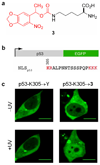Recent advances in the photochemical control of protein function
- PMID: 20667607
- PMCID: PMC2926219
- DOI: 10.1016/j.tibtech.2010.06.001
Recent advances in the photochemical control of protein function
Abstract
Biological processes are regulated with a high level of spatial and temporal resolution. To understand and manipulate these processes, scientists need to be able to regulate them with Nature's level of precision. In this context, light is a unique regulatory element because it can be precisely controlled in terms of location, timing and amplitude. Moreover, most biological laboratories have a wide range of light sources as standard equipment. This review article summarizes the most recent advances in light-mediated regulation of protein function and its application in a cellular context. Specifically, the photocaging of small-molecule modulators of protein function and of specific amino acid residues in proteins is discussed. In addition, examples of the photochemical control of protein function through the application of genetically engineered natural-light receptors are presented.
Copyright 2010 Elsevier Ltd. All rights reserved.
Figures






References
Publication types
MeSH terms
Substances
Grants and funding
LinkOut - more resources
Full Text Sources
Other Literature Sources

